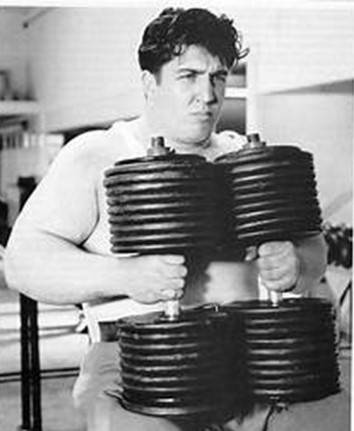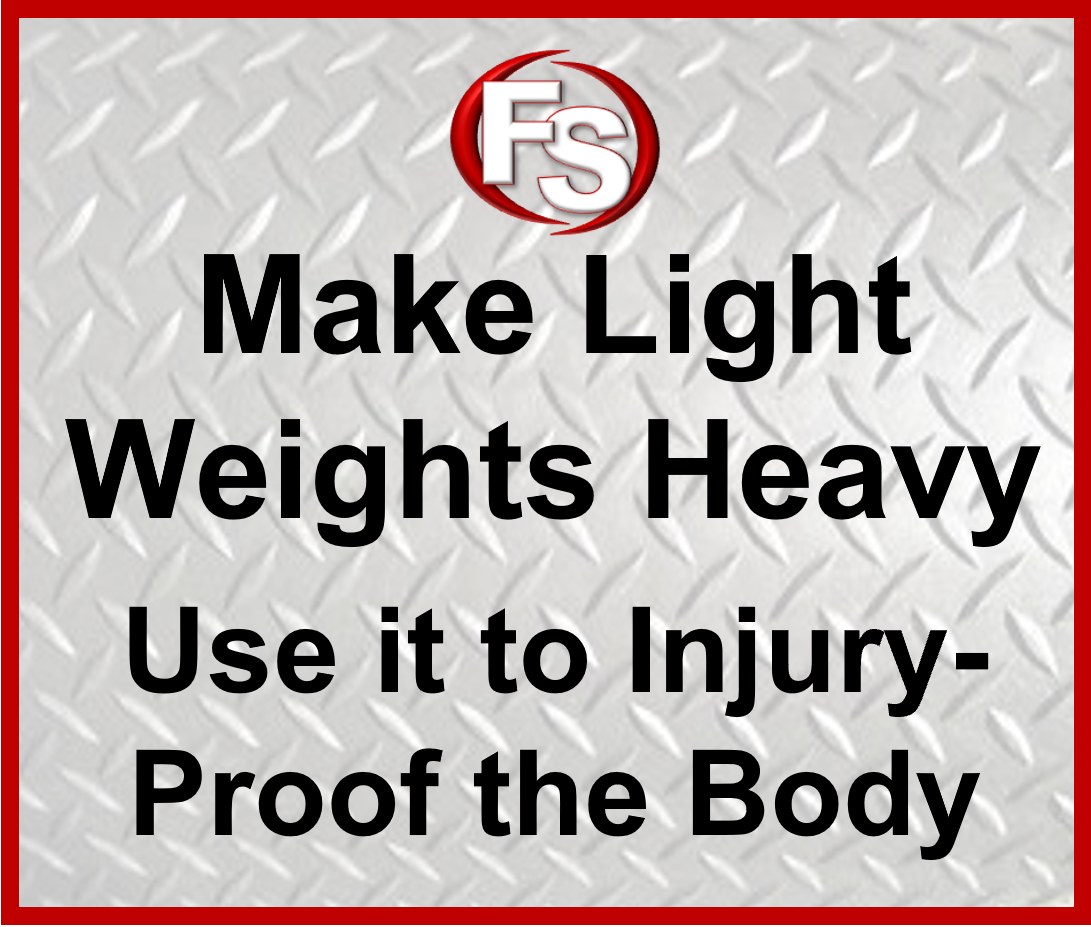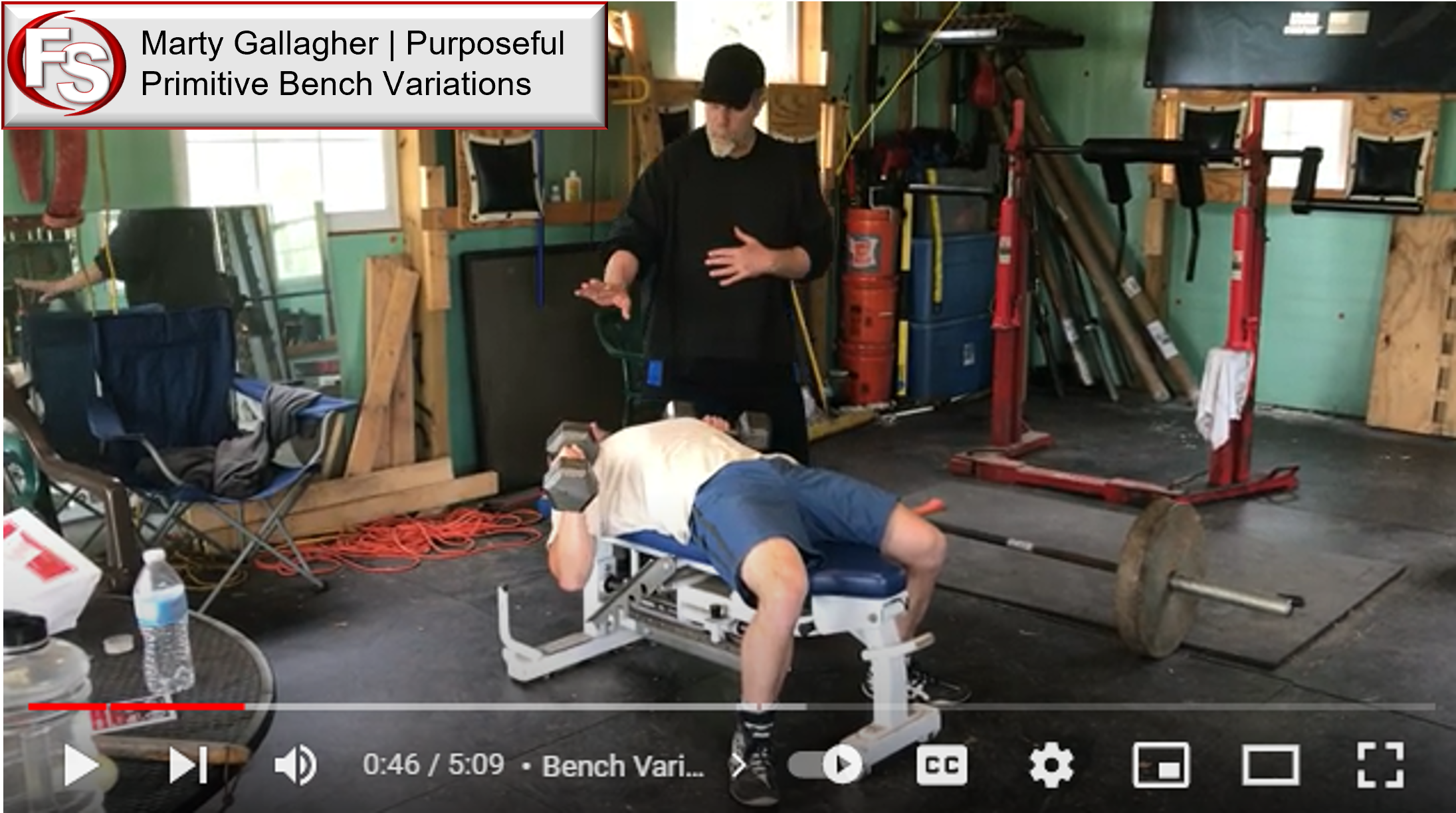
Old School Grand Maestro: Pat Casey ready to roll back and bench a pair of 200s from a stretched dead-stop
Making light weights heavy and Below Zero: One of our overarching strength strategies is the idea of “making light weights heavy.” This four-word phrase is what Norman Mailer would call, “a chocolate covered factoid” a bumper sticker slogan that effectively epitomizes an idea, a philosophy, in ten words or less. One way in which to make light weights heavy is to “disadvantage” the progressive resistance lift being performed. Exercises done with exacting technique increases the degree of difficulty for any lift. We developed and practice highly exacting signature techniques that disadvantage a lift - also accomplished by using various “intensity enhancers.”
Our school of strength has five sequential variations for each of the “core four” lifts: squat, bench press, deadlift, overhead press. The 1st variation of each of the five variations is dubbed, Below Zero. Below Zero is another bumper-sticker bon mot that identifies a way, a method (and tools needed) that enable the injured, sickly, the feeble, the neophyte, to engage in “no compromise” strength training: result-producing, hypertrophy-inducting, strength-building methods that requires little if any time, use small payloads, and safely strengthens those that need strengthening the most.
Below Zero is a mode of exercise doable by the weakest of weak, the injured, the sick, those on the mend, the enfeebled; those in need of strength yet too weak to handle the lightest resistance. The challenge for weak is finding ways in which they can replicate the requisite techniques in each of the core four lifts.
Replicate techniques, tailor the payloads, replicate results. Below Zero provides tools and tactics that empower the weak (without compromise) to participate in serious strength training. Below Zero can also be thought of as entry-level strength training for the uninitiated. Proper depth squats are undoable by the weak. In Below Zero squatting, the goal is to “assist” and enable the weak-legged squatter in one of two ways…
Create a box that requires the trainee to squat down a mere six inches. Teach the partial rep squatter the correct way to inhale on the descent, how to lightly touch the box, don’t settle and relax between reps. Touch and go. Upright posture, keep the pelvis tucked under. Do not arch the spine. Sit back and down, keep knees over ankles throughout. Knees pinned out on descent and ascent. Coil on the negative, no freefalling. No leaning forward.
Periodized Plan: After the trainee can perform three sets of 8 reps, drop the box height six-inches. This might knock the trainee back to 3x5. Stay with it. Work back up to 3x8. Keep dropping the box until there is no more box to drop. Then onto Goblet squatting.
The other (preferred) alternative is the “assisted” squat. The idea is to attain full range-of-motion right from the start. Utilize a pole, doorframe, or suspension trainer to self-administer forced reps. Resist while lowering thereby lightening your torso. Pull upward while ascending, giving yourself as much assistance as is needed to complete perfect reps. The lightening of the bodyweight via the suspension trainer enables Below Zero trainee to work leg muscles over a full and complete ROM.
Periodized Plan: The initial goal is for the trainee to work up to one set of 8 perfect reps. Then two sets of 5 reps. Work upward to two sets of 8. Now shift to three sets of 5, over time ending at 3 sets of 8. Now the goal shifts: maintain 3 sets of 8 reps, over time using less and less pulling until none is needed. See post buttons below for information on suspension trainer squatting and goblet squatting.
The technique built and perfected performing Below Zero assisted squats and depth squats is identical to the sought-after Goblet squat technique. Below Zero precedes Goblet squatting and G-squat mastery precedes the introduction to the barbell front squat. After becoming adept at BB front squat, onto hi-bar back squatting. Then and only then do you “earn” the right to commence low-bar back squat. What about the other lifts?
Bench press Below Zero tactics include using steep incline and, once again, suspension training devices. Below Zero deadlift tactics utilize (perfectly performed partial reps) ROM deadlifts. A short, correct rep stroke acclimatizes the weakened individual to the proper pulling technique. Over time, the partial rep stroke is lengthened. Overhead pressing using Below Zero commences with small hand weights that are incrementally increased as poundage is mastered.
The advantages to disadvantaging the core lifts are numerous: first and foremost, you get stronger using less poundage. Simultaneously, full range-of-motion movements create flexibility and maintain function-ability, critically important in our sedentary society. Function and flexibility (bestowed by “iron yoga’) are most valued as humans age.
How do you go about disadvantaging a core lift, say the bench press?
The best possible tool choice for entry-level free-weight bench pressing is dumbbells. The dumbbells increase instability by placing two payloads at the end of long levers, your arms. This causes muscle stabilizers to go crazy, a fantastic thing from a strength-infusing, muscle-building perspective. Dumbbells force each arm to carry their fair share, each arm deals with the exact same payload. With a barbell, the strong arm might exert more (say 51.4 %) while the weak arm contributes less (say 48.6) to the push effort. If you set about trying to make progressive resistance bench pressing as hard as humanly possible, if the goal was to create a maximally disadvantaged bench press, what would you do?
If the poundage, the payload, is correct and appropriate, dumbbell bench pressing allows for a “pre-stretch” not possible with a barbell. To make the dumbbell bench press harder, after lowering the bells on an inhalation, instead of pressing the bells – exhale, relax the chest, arms, and shoulders and allow the bells to stretch these tight muscles. This is Iron Yoga. Now reengage and push upward. Fight against the urge to explode the reps upward: exploding makes pushing easier.
To make relax-and-stretch dumbbell presses harder still, pause for a beat before consciously reengaging relaxed-and-stretched pectorals and deltoids to begin the upward push upward. How long a pause? “Barely paused,” as short as possible, yet undeniably a pause. You need be very focused during a set of paused, pre-stretch dumbbell benches. Relax deeper to commence each subsequent rep, alertly reengage to begin the upward push after a definitive pause.
Every set of bench presses, barbell, or dumbbell, needs to be fully and completely locked out at the conclusion of every rep. If you are unable to lock out a bench rep, curtail the set. 90% of all bench pressers use what is called a “soft” lockout, never fully straightening the arms, never achieving a bone-on-bone lock. A complete lockout activates the triceps. Those using a soft lockout end the rep at the point where the triceps must finish the last 6 inches all alone. Soft lockouts create weak triceps.
90% of the world’s bench pressers accomplish the negative, the lowering of the barbell or dumbbells by letting gravity do the work. The free-fall negative is guided down to a touch point on the chest. Rebound is often used, a slight bounce off the ribcage can be used to create upward momentum. The elite bench presser consciously resists the negative, thereby enabling muscle fiber to “coil” energy. The elite do not throw away the muscle-building strength-infusing benefit of the negative.
Before every set, select from one of three potential rep speeds: grind (slowed) normal (normal) explosive (fast as possible.) Proper grind speed is ‘barely’ slowed. how do you make the pre-stretched, paused, controlled-negative, hard-lockout, dumbbell bench presses even harder? Take away explosiveness. Exploding is easy; grind is excruciating. By rep 5, lactic acid build-up is intense; grind speed extends the set length. Over time and with repetition the bench presser extends their “lactic acid threshold.”
If the dumbbell bench presser uses the always preferred controlled, ‘barely slowed’ negative and pairs that with a ‘barely slowed’ grind rep speed on the concentric push phase, an even-steven up and down pace is established. An 8 rep set takes an eternity to complete. This strategy combined with pauses and hard lockouts is an exercise in mirror-image evenness, the bencher appears machine-like. The eccentric and concentric and mirror images of one another both in technique and pacing.
When you slow down the eccentric and the concentric, when you use a purposefully maximum range-of-motion, a controlled, coiled eccentric followed by the pre-stretch and a pause, this is followed by a grind-speed (purposefully slowed) concentric ending in a hard, distinct, bone-on-bone lockout. Maximum muscular inroad is dug using (relatively) light poundage. Classical strength training favors the 5 rep set, dipping down to 3s and upward to 10. 6 and 8 rep sets are also favored.
Everything is strength training (as opposed to bodybuilding) is about “techniques and tactics.” Once you understand the technique, in this case, the pre-stretch dumbbell grind-speed bench press, then the technique need be set in motion. The strategy is to increase poundage-handling ability or increase repetitions with a current limit poundage. The classical “periodized strength cycle” last 10-12 weeks. Each week poundage or reps are moved upward. As the cliché goes, “A goal without a plan is a wish.” Periodize!
When asked about frequency, much depends on how rapidly the athlete recovers from the resistance training session. For the super-fit, they might bounce back 100% from a 100% strength training session in 3-4 days. Others might need 5-7 days to fully recover from a hypertrophy-inducing training session. There is no progress to be made training at 100% of capacity when only 77% recovered from the previous session. This called the rested effort: train at 100% of capacity when 100% rested.
Check out the video below with "Riley the Robot" where he helps me demonstrate the techniques outlined above. Also please feel free to send us a question here or leave a comment below.
Break out the Dumbbells: This is one hell-of-a-lot of bench press disadvantaging. Leave your ego at the door performing the pre-stretch grind-speed dumbbell bench press. This exercise is unlike any other bench pressing you have ever done, and the poundage used will be 33-40% less than what you could handle in the “regular” dumbbell bench press. The tips outlined will give you quite a bit to work on. All other forms of bench pressing are easy by comparison. Easily master all the subsequent bench variations once the pre-stretch DB core variation is mastered.
Five Sequential Iterations of Bench Pressing
- 1Below Zero - suspension trainer, pre-stretch DB bench
- 2Dumbbell Bench Press - pause or touch & go
- 3Barbell Bench Press - Competition Grip Width - pause or touch & go
- 4Barbell Bench Press - Wide Grip - pause or touch & go
- 5Barbell Bench Press - Narrow Grip - pause or touch & go
Each of the five sequential variations builds on its predecessor and lays the groundwork for its successor. These five bench press variations need to be periodically revisited. When stagnation and staleness take ahold, loop back around to the bench press ultra-basics. They are an eternal wellspring of chest, shoulder, and arm power and strength. Become a technical fanatic and maximize gains while minimizing both poundage and chance of injury.

Learn more about our signature training techniques. Check out the posts below.
Learn more about our philosophies check out our site Functional Strength. Join the community sign up below to our newsletter and receive our FREE Planning and Periodization Guide. Please feel free to send us a question here or leave a comment below.
Want the inside training scoop?
Join The Community
Our email content is full of value, void of hype, never pushy, and always free. As a BONUS you will receive our FREE planning & periodization template to help you with your training goals.






